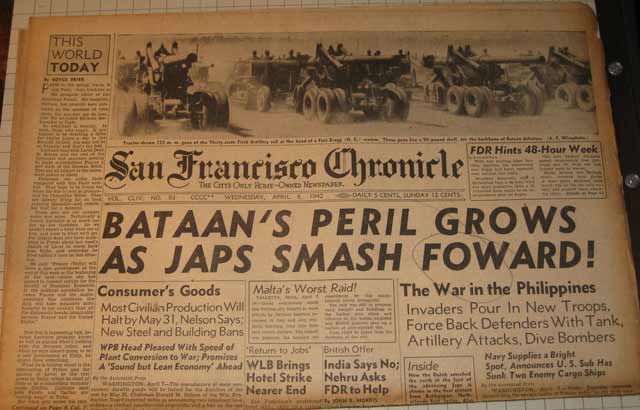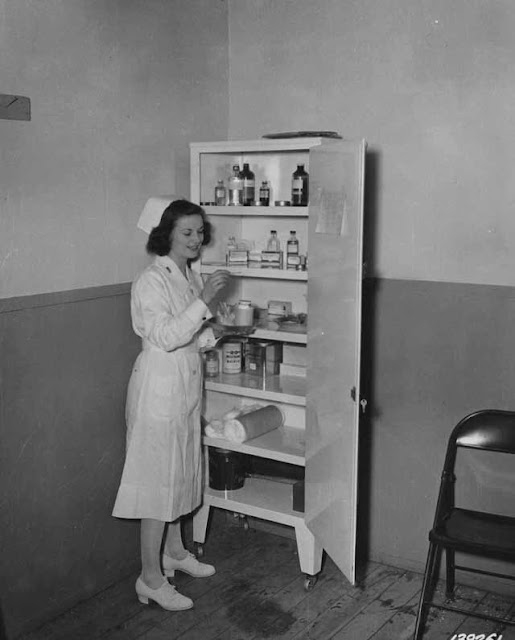Wednesday 8 April 1942
Only a very few lucky Allied soldiers evacuate aboard minesweeper/patrol boat YAG-4 from Mariveles Naval Base, where the navy scuttles massive floating drydock "Dewey." About 2000 men sail to fortified Corregidor Island in Manila Bay. Submarine USS Snapdragon delivers supplies to Corregidor and evacuated naval radio and communications intelligence experts.
 |
| San Francisco Chronicle, 8 April 1942. The headline "Bataan's Peril Grows" could not be more accurate. |
Japanese troops supported by light cruiser Tatsua, destroyer Mutsuki, and carried aboard Mishima Maru land on Lorengau, Manus Province, New Guinea, in the Admiralty Islands. As the soldiers of the 8th Special Base Force land at Lorengau harbor, the small group of Australian soldiers from the No. 4 Section, B Platoon, 1st Independent Company withdraw into the jungle. The Japanese quickly begin building an airstrip. Other Japanese troops occupy the town of Djailolo on Halmahera Island in the East Indies.
US Navy Admiral William "Bull" Halsey leads his Task Force 16, led by the aircraft carrier USS Enterprise, out of Pearl Harbor on 8 April 1942 on a top-secret mission. His orders are to rendezvous with the USS Hornet, already at sea, and support its mission to bomb Tokyo.
 |
| The San Diego Union of 8 April 1942 touts glorious US victories at sea while less prominently noting that "Nippon Hordes Gain in New Bataan Attacks." |
Fighting in Burma has paused temporarily on the ground, but it remains ferocious in the air. The American Volunteer Group (Flying Tigers) sends its 1st and 3d Fighter Squadrons over Loiwing Aerodrome and they claim to shoot down a dozen Japanese fighters.
 |
| Undated photo of an unidentified US Army Air Force navigator who flies supplies to China across "The Hump" during World War II. |
 |
| Luftwaffe aerial reconnaissance photo of the Soviet pocket at Sevastopol, Crimea, 8 April 1942 (Federal Archive Image 168-278-030). |
European Air Operations: During the day, the RAF sends four Boston bombers on a sweep off the Dutch coast. After dark, RAF Bomber Command mounts a major raid on Hamburg. It sends 272 bombers - 177 Wellingtons, 41 Hampdens, 22 Stirlings, 13 Manchesters, 12 Halifaxes, and 7 Lancasters - but the weather is poor, with icing and electrical storms. Only a small fraction of aircraft actually bomb Hamburg, causing 8 fires and killing 17 people and injuring 119. One of the bombers bombs Bremen by mistake and causes more militarily significant damage to the Vulkan shipyard there than by the main force over Hamburg. There also are minor raids by 13 Wellingtons to Le Havre, 3 Blenheims over Holland (Eindhoven, Haamstede, Leeuwarden and Schipol Airfields), 24 minelayers off Heligoland, and 16 leaflet-droppers over Belgium and France. The RAF loses four Wellingtons and a Manchester on the Hamburg raid and one of the leaflet planes for a 1.8% loss rate.
 |
| US floating dock "Dewey," scuttled on 8 April 1942 in Bataan, the Philipines to avoid capture by the Japanese. |
U-84 (Oblt. Horst Uphoff), on its fourth patrol out of Brest, gets its first victory of the war about 180 miles southeast of Cape Sable, Nova Scotia. It is 5226-ton Yugoslavian freighter Nemanja (13 dead and 34 survivors). This sinking occurs after a nine-hour chase during which U-84 missed with two torpedoes.
Italian submarine Pietro Calvi torpedoes and sinks US freighter Eugene V.R. Thayer off the coast of Brazil.
German 734-ton freighter Kurzesee hits a mine laid by Soviet submarine K-1(Captain 3rd class Avgustinovich) earlier in the day. It sinks off Kvaenangenfjord (Skjervøy), Norway. Swedish 2374-ton freighter Ara hits a mine and sinks off Terschelling, Friesland, the Netherlands.
Soviet submarine ShCh-421 hits a mine in the Barents Sea and is irreparably damaged. Everybody survives the sinking, which actually concludes on 9 April 1942.
The British Admiralty scuttles 3645-ton freighter Carolina Thornden as a blockship in Water sound, Scapa flow.
Battle of the Mediterranean: Luftwaffe Field Marshal Albert Kesselring's air offensive against Malta reaches its climax. Royal Navy cruiser HMS Penelope (three dead), under heavy attack, heads out of Grand Harbor at 20:00 to avoid destruction and fights off repeated air attacks on its way to Gibraltar. Mooring vessel Moor (767 tons) hits a contact mine dropped by the Luftwaffe and sinks (28 deaths, one survivor). Today's attacks become the worst one-day attack on Malta of World War II.
The Italian Regia Aeronautica also attacks shipping at Alexandria. The planes sink Royal Navy whalers HMT Thorgrim (307 tons, refloated in 1950) and Svana (268 tons).
Anglo/US Relations: Harry L. Hopkins, a close crony of President Roosevelt, and Army Chief of Staff General George C. Marshall arrive in London, England. They are there to discuss the arrival of US troops, naval units, and air formations.
US Military: The US Army Air Force activates the 9th Air Force with its headquarters at New Orleans. This formerly was the V Air Support Command.
 |
| HMS Penelope, showing battle damage sustained at Malta. |
The Italian Regia Aeronautica also attacks shipping at Alexandria. The planes sink Royal Navy whalers HMT Thorgrim (307 tons, refloated in 1950) and Svana (268 tons).
Anglo/US Relations: Harry L. Hopkins, a close crony of President Roosevelt, and Army Chief of Staff General George C. Marshall arrive in London, England. They are there to discuss the arrival of US troops, naval units, and air formations.
US Military: The US Army Air Force activates the 9th Air Force with its headquarters at New Orleans. This formerly was the V Air Support Command.
Canadian Government: The Canadian government creates the Park Steamship Company to build freighters specifically designed for wartime service. These become known as Park ships and sail alongside Liberty ships built in American shipyards and Fort ships built in Great Britain.
American Homefront: The War Production Board expands on earlier orders that have terminated the production of civilian automobiles and some other consumer goods. It orders a halt to all production deemed unnecessary to the war effort as of 31 May 1942. As workers shift to the military and war work, the unemployment rate begins edging down from a 14% rate in 1940.
Future History: Roger Maxwell Chapman is born in Leicester, England. He becomes the vocalist for the Farinas, who release their first single, "You'd Better Stop," in August 1964. He later fronts a succession of acts, most notably Family, as a distinctive singer and showman. Much of his career is in Germany, where he is awarded a Lifetime Achievement Award in 2004. After giving a "farewell performance" in 2010, Chapman appears to be retired as of 2020.
Leon A. Huff is born in Camden, New Jersey. He becomes a top songwriter, helping to develop the Philadelphia soul music genre along with partner Kenneth Gamble. As Gamble and Huff, they are inducted into the Rock and Roll Hall of Fame in the non-performer category in March 2008.
 |
| "Thrilling Wonder Stories," April 1942 (cover art by Earle K. Bergey). |
April 1942
April 1, 1942: Convoys Come to the USAApril 2, 1942: Doolittle Raiders Leave Port
April 3, 1942: Japanese Attack in Bataan
April 4, 1942: Luftwaffe Attacks Kronstadt
April 5, 1942: Japanese Easter Sunday Raid on Ceylon
April 6, 1942: Japanese Devastation In Bay of Bengal
April 7, 1942: Valletta, Malta, Destroyed
April 8, 1942: US Bataan Defenses Collapse
April 9, 1942: US Defeat in Bataan
April 10, 1942: The Bataan Death March
April 11, 1942: The Sea War Heats Up
April 12, 1942: Essen Raids Conclude Dismally
April 13, 1942: Convoy QP-10 Destruction
April 14, 1942: Demyansk Breakout Attempt
April 15, 1942: Sobibor Extermination Camp Opens
April 16, 1942: Oil Field Ablaze in Burma
April 17, 1942: The Disastrous Augsburg Raid
April 18, 1942: The Doolittle Raid bombs Japan
April 19, 1942: British in Burma Escape
April 20, 1942: The Operation Calendar Disaster
April 21, 1942: Germans Relieve Demyansk

